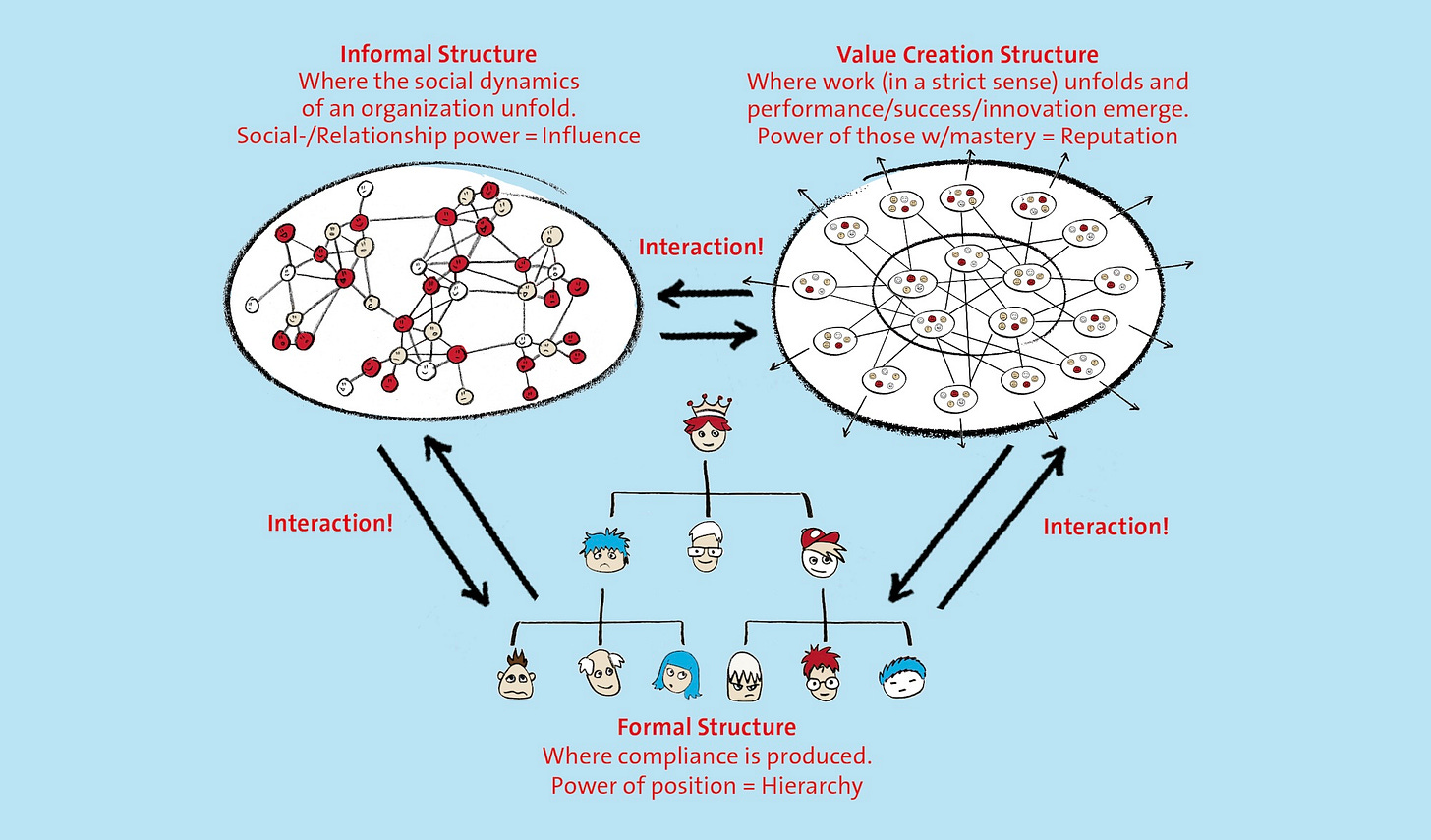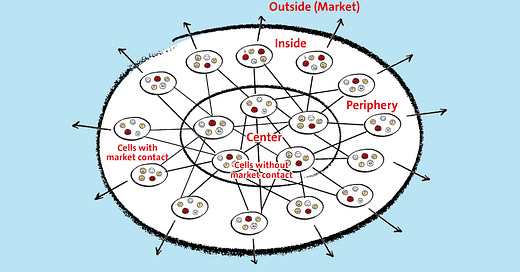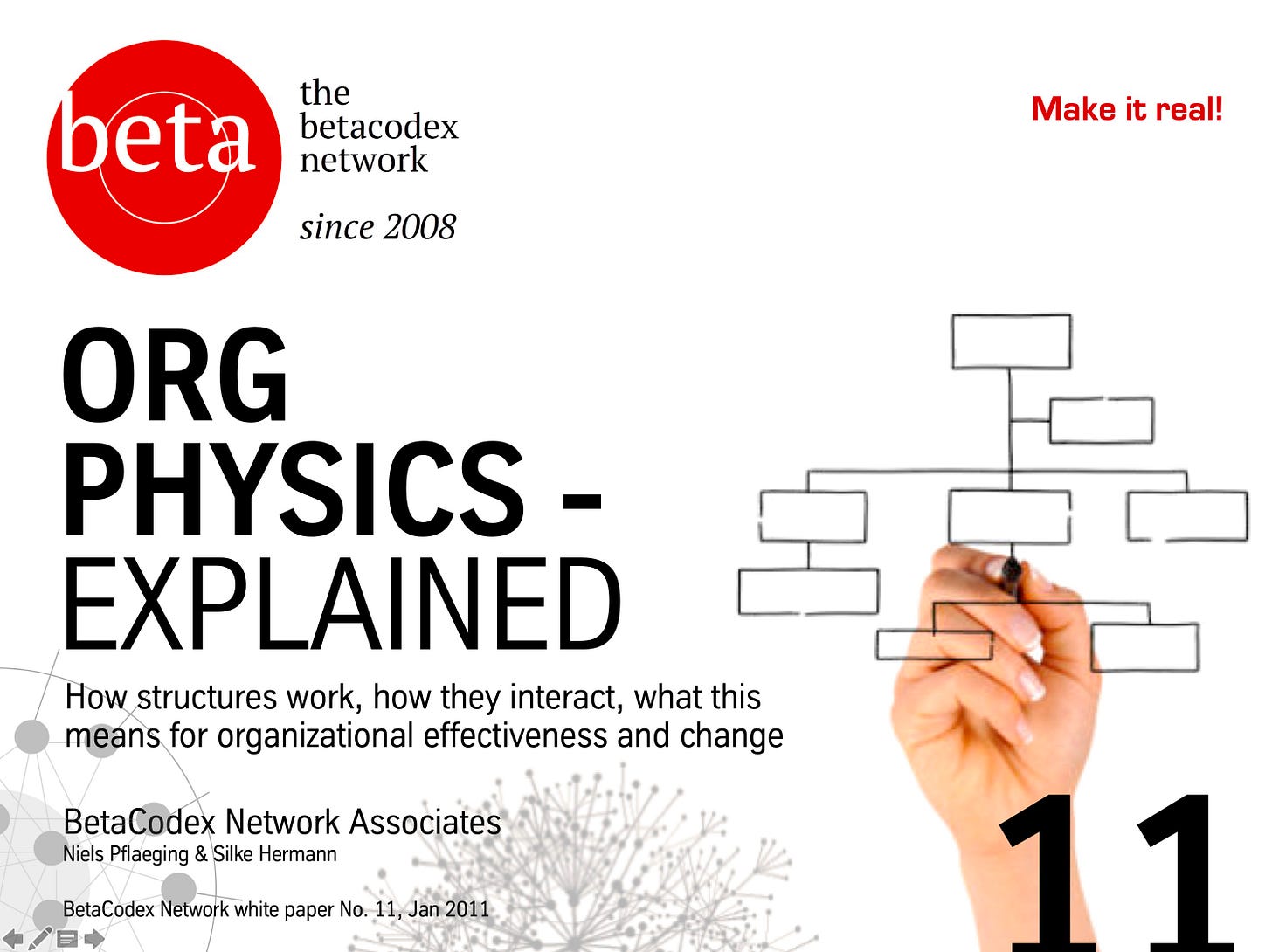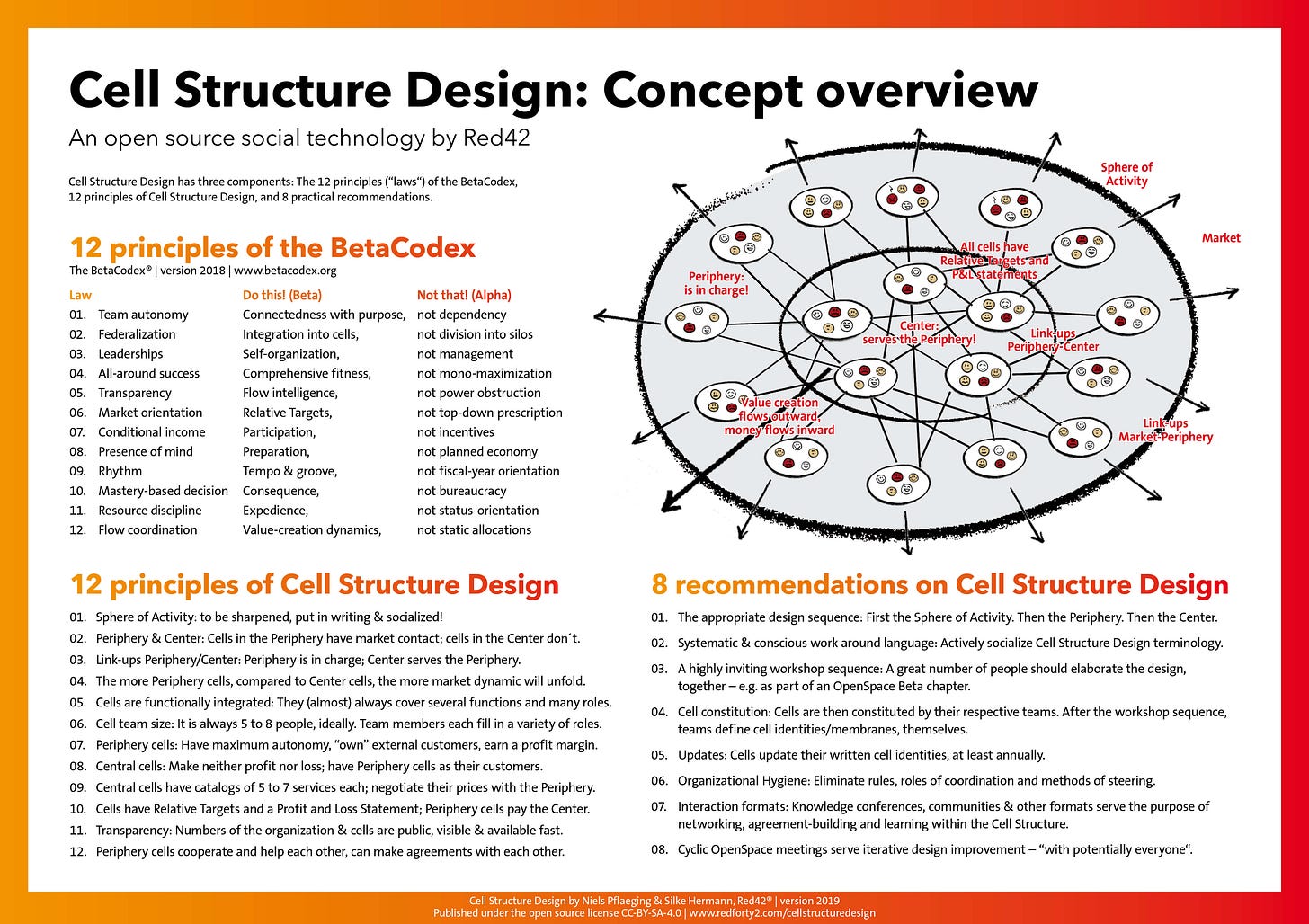If it doesn't distinguish Periphery and Center, it's not modern org design at all
The overwhelming amount of organization design concepts fails to acknowledge the fundamental distinction that matters most in complexity
An era of org design has come to an end: Throughout the 2nd half of the 20th century, notions of organizational structures were largely dominated by command-and-control thinking: centralized steering, combined with functional division into silos, business areas and departments like sales or production seemed inevitable. Consider the greatest hit in org design in the 1980s, Matrix Structures: It turned multi-dimensional control pyramid overlays into a fad – multiplying the need for steering and coordination, and creating further burdens for business. None of that halted the adoption of Matrix Structures around the world, and the approach became more recently became reincarnated in several varieties, with names like Spotify Model or SAFe. While such concepts have consistently failed to produce significant improvements, few companies have truly moved beyond command-and-control org design, in order to attempt decentralization of decision-making to the periphery.
The problem with the overwhelming share of popular concepts around organizational design, organizational structures and org development is that they consistently fail to appreciate the crucial distinction between Periphery and Center. Those approaches are stuck in the past, and for a simple reason: They simply cannot give useful answers to organize work in the face of complexity and volatile markets.
This failure to respond to the common challenges of complexity continues. Just open a book by Naomi Stanford, one of the world’s leading authorities on org design, who published several influential books on the topic. In Standford’s books, you can read a lot about centralization, bureaucracy and the burdens of not getting org design right. But there is close to nothing about decentralization that would reach beyond the simplistic concept of “business units”, or vague-sounding notions of “organizations as networks”.
In recent years, fads like sociocracy and holacracy have added to the misery in theory and practice: Those tools introduced the concept of circles and “alternative decision-making structures” (especially consent) to the mix of org design recommendations. But such approaches only add further burdens to command-and-control-plagued companies, as they install painstakingly facilitated and technocratic meeting routines, with committees (circles) being installed for infinite purposes, thus establishing toxic steering mechanisms that further erode team-based self-organization and accountability. The field of Org Design, in short, is stuck in a dead end.
What if the field of Org Design began to face the complex realities?
BetaCodex approaches are different from obsolete org design dogma in that they actually solve business problems, instead of perpetuating or aggravating them.
They consistently distinguish between Periphery and Center: The BetaCodex maintains that decentralization is not optional, but a practical necessity, in complex markets, and that it is teams in the periphery (and people with mastery within them), that need to be in charge in all matters related to daily business.
They promote functional integration into cells, instead of functional division through silos or departmentalization. Your organization has a sales department, committees, budgeting, intense forecasting and fixed targets? Then your company is clearly functionally divided and lacking, or eroding self-organization.
They are based not on lofty aims or ideology, but on scientific theory and real-world cases of companies that have been decentralized for years or decades – such as Buurtzorg, Toyota, dm-drogerie markt, W.L. Gore, Southwest Airlines or Handelsbanken.
Decentralization: From hunches to solid practical theory
There is a now "triad of practical theories" underpinning decentralization. You are invited to get (more) acquainted with all three concepts:
The BetaCodex – a meta-theory for organizing and the alternative to “management the social technology”,
OrgPhysics (see visual below) - a powerful theory distinguishing three kinds of structures, three kinds of power and three kinds of leadership that exist in every organization
Cell Structure Design – a potent open source social technology that combines BetaCodex and Org Physics, allowing for every organization to adopt consistent decentralization – aligning their structures with flow and value creation.

With these concepts, consistent decentralization of organizations of all kinds and sizes has recently become viable. These ideas are not entirely new, though. They gained contour in the work of the Socio-Technical Systems movement (1940s to 1980s). They were further fleshed out through the case-study-based research of the Beyond Budgeting Round Table between 1998 and 2007. In our work with the BetaCodex Network, we took the existing concepts to yet another level, starting in 2008:
We added concepts and theories from different sciences, and created further theory ourselves. The achievements are highlighted in
We turned abstract theory into highly practical social technologies, such as Cell Structure Design
We consistently visualized the concepts of decentralization, first through the peach model illustrations, and then more thoroughly for the Organize for Complexity white paper and book)
We applied the concepts of decentralization in dozens of companies, starting in 2003, which led to the publication of several research papers, and also to a robust body of conceptual insight and consulting knowledge.
All organizations as "peaches": Value Creation flows from Center to Periphery to external market - inevitably. In complex markets, the Periphery needs to be in charge
While the concepts of decentralization currently seem to be a "unique selling point" of the BetaCodex community, we cannot highlight enough that all BetaCodex theory and practice is, by definition, applicable in every organization, and that the concepts are open source and freely usable under open source licenses of the BetaCodex and Cell Structure Design.
Decentralization is more than just some arbitrary org design principle
Decentralization amounts to something like a natural law of organizing in complexity. It is natural to organizing in dynamic markets, and to ignore today’s prevailing market forces produces the many kinds of waste and suffering that have been widely discussed for decades. But decentralization also holds a somewhat political message. Because organizational decentralization is rooted in the belief that all people are Theory Y people, and self-motivated human beings who intrinsically wish to contribute to something bigger than themselves: People need to work to feed themselves and their loved ones, but they also want to self-fulfill at work, if conditions are appropriate. Decentralization is thus rooted in the belief that people are capable citizens, in principle.
Any approach to organization design that does not distinguish between an organization’s periphery and center is not just flawed and useless, but also dangerous
Decentralization is political because it assumes that people need not be controlled by "bosses" and the top, nor controlled by authoritarian "performance management" processes. In short, decentralization implies that far more organizational democracy is possible. And that the democratic distribution of power is actually natural to organizations. Far more natural than command-and-control pyramids and centralized steering.
Some further reading
The Organize for Complexity research paper from the BetaCodex Network:
The original BetaCodex Network research paper on Org Physics:
Learn more about the BetaCodex here: betacodex.org








